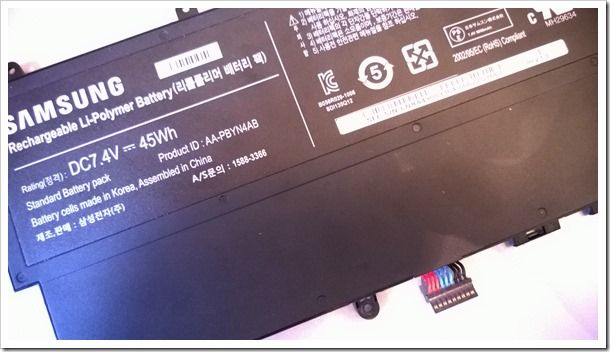
Take a look at the back of most Ultrabooks and you’ll find nothing. By having sealed-in batteries the OEMS save money, weight and space. The owner, however, is left with the big unknown of battery lifetime and if you’ve ever owned a laptop you’ll know how totally useless they are when you have to drag the mains cable around with you everywhere. I recently had to order a new internal battery for a Samsung Series 5 NP530 that is under two years old and has zero battery capacity. On the other hand I’m typing this on a two-year old Ultrabook that still has 85% battery capacity. So how long will the average battery last?
No-one can tell you how long your battery will last. Samsung claim that their Ultrabook batteries will still have over 80% capacity after two years if you turn on their 80% charge limiter, but they won’t guarantee it. Most other manufacturers won’t claim anything and there isn’t a manufacturer out there that tells you how much it will cost to replace a sealed-in battery before you buy the product. While I’m happy with sealed-in batteries for the reasons mentioned above, I’m not happy with the variance in quality. If a battery is sealed-in it needs to have some sort of guarantee. 2 years and 75% should be a minimum and not just because the customer needs it. Replacing batteries is harmful to the environment and manufacturers need to be held responsible for replacement and disposal.
How to check your battery capacity
For more background information and a great set of comments from readers, read this: Check and Improve your Battery Life Expectancy
I’ve just replaced the battery on a Samsung Series 5 and the how-to is below. Although the Ultrabook was used on a desk, plugged in, five days a week, the battery shouldn’t have died like it did. It was clearly faulty and should have been a warranty case but as I’d already hacked about with the cover it probably would have cost me a fair bit of money. Instead I chose to find a replacement, which wasn’t easy.
Finding out what battery you have is the first problem and to be 100% sure you’ll need to open up your laptop and get the battery part number. Once you’ve got that it’s easy to find replacements and you’ll usually end up with two types. The original part will almost always be available through the official support channel but it’s going to cost you. Finding the original part for self-install is a bit more difficult. What you’ll usually end up with, because of price and availability, is a pattern (copy) battery from China. Quality is not guaranteed and you’ll almost certainly have little chance of replacement if it’s faulty. If you do find a company that will replace it, sending a Li-Ion battery back to China requires paperwork and time that you probably haven’t got.
My experience was good though. I used a local site called StoreAkku.de. It turns out it’s a front-end for a company working out of Hong Kong that gets an international shipping agent to send the required part. Ordering was easy and an email 24 hours later asking for confirmation of laptop model and / or photo of the battery gave me confidence. The price was good (70 Euros including delivery) and it turned up without any customs charges in about 10 days.
Samsung Series 5 (NP530U3B) battery replacement.
The process is fairly simple and I’ve included a video below.
Notes: Shut down your laptop before starting. Place a soft cloth under the device. Be careful of the hard drive as it is fragile. Once you’ve removed the cover you’ll lose your warranty for anything else that might go wrong. This is an unofficial guide and comes with no guarantee.
- Undo the drive access panel and remove drive
- Remove mid-casing screws. (one)
- Remove casing edge screws
- BE CAREFUL when you prise the casing off. The metal as very thin and sharp at the edges. Work from front to back with the final lift at the corner where the power input is. Be careful of the plastic near the ethernet port as it can split easily. (Mine did!)
- Undo battery screws. Remove tape covering WiFi antenna cable that is routed on the battery edge. Lift battery and remove power connector.
- Insert new battery in the reverse process.
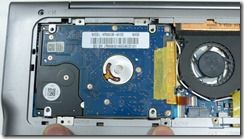
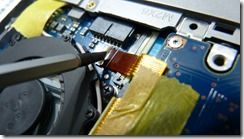
First thing to do is to remove the drive and drive cable.
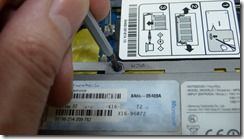
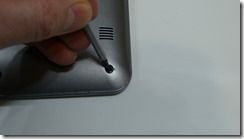
Remove the third mid-case screw and then the rest of the case screws.
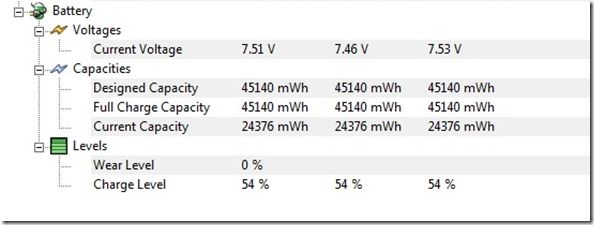
CPUID HWMonitor can tell you how much capacity and charge you have.
Video: Samsung Series 5 Ultrabook battery replacement.
What’s your experience of Ultrabook batteries? How much charge capacity do you have left? (find out using this method.) Have you had to replace a sealed-in battery?











You should blur the w7 product key on the picture above
Thanks!
“Although the Ultrabook was used on a desk, plugged in, five days a week, the battery shouldn’t have died like it did.”
Of course it does. It’s fundamental to the battery technology. Doing something that isn’t recommended then complaining don’t put manufacturer at fault.
I’ve seen it many times with laptops that are used like desktops.
How hard is it to simply turn it off when there’s a battery warning? Or actually use it like a PORTABLE when the battery is charged? The effort saves money, and if you don’t, then few years later you pay for it. Simple.
I’ve got Ultrabooks here that have been used as desktops and they don’t show anything like the wear that the Samsung saw. It was 0% after 18 months. Even Samsung themselves said something was wrong when I told them at MWC.
This is why I only buy notebooks with replaceable batteries that doesn’t need screws and can be purchased from the OEM directly or at least reputable retailers. I’ve had my share of fake batteries from China that didn’t last as long or had reduced capacity. Good thing I didn’t get any exploding ones like some of heard about.
I also look for notebooks that can set charge thresholds. Preferably within the OS and not just the BIOS. I set it to 70%-80% most of the time. If I’m going to be plugged in for a while I set it to 45%-55%. I could remove the battery but that’s a pain and the battery can also serve as an UPS.
For a notebook, I must have replaceable RAM, storage drive and battery. As pluses, I’d like replaceable WiFi and WWAN.
The main thing I get out of this article is that sealed batteries == bad.
Honestly, I’d rather have my tasks dictate how I use my notebook and not battery maintenance determining it. To me, that’s very much worth just buying a battery down the line and popping it in. Of course, I only buy notebooks with externally accessible batteries.
This is why it will be quite I while before my Thinkpad X201S will be replaced.
1440×900 12,1″ LCD, standard 9,5mm HDD/SSD, and replaceable batteries,Also a ecosystem of dockingstations and external battery chargers.
While it’s limited to 8GB RAM it isnt a artificial limit like on some ultrabooks and tablets7hybrids these days.
Its a little thicker and heavier at 1,4kg and 29mm but honestly its worth it for an excellent keyboard and the ability to just smile when the Macbook Air-heads are frantically fighting for oulets and getting tangled in charging cords while you just snap in a new battery.
Not that you usually need a new battery since you have the option to choose sizes and an extended one usually lasts a whole day with normal use.
Charging time? Let me shut the lid and turn it over. A minute? Maybe less? Thats very hard to beat
Imagine a laptop with the same features, physical design and connectors manufactuered with more modern tech, more effective processor and graphics card, more ram.
Ultrabooks is proof that marketing and market forces can turn anything into shit. “These new soggy cardboard hammers are great!”
If this trend keeps up my next laptop will probably be somekind of DIY affair in an old Thinkpad shell.
While I’m sure there is a few use case that actually need very thin laptops it was mainly a push for planned obsolescence in laptops.
I always buy the extended battery option for my notebooks. I also take a second extended battery if I need it like on planes (even plugs at airports are already taken or I have to sit on the ground to use one) or I plan on doing heavy CPU stuff while I’m unplugged.
There are currently just too much compromises with this whole sealed thing for minimal aesthetic gain. SSDs can also fail before the rest of the notebook and likely after the warranty period of the notebook. RAM is always more expensive when buying from the OEM and, in rare cases, they can also fail.
The whole sealed thing just won’t work on notebooks. It may be fine on phones that probably get accidentally damaged (either sudden or from rough use over time) before the battery loses too much capacity, the RAM becomes too little for current apps and OS version or storage becomes too slow and/or to small.
The ironic think is that phones often are easier to hold with an extended battery. Less slippage. And not being able to run the latest games and Facebook app on a smartphone isnt a big deal its if its actually used as a smartphone with mail, music and notes as the main usages.
An as always batterytime from the marketing department only apply when watching a black picture with all radios off
Its only tablets that have an actual case for integrated glued down batteries. And there you will be needing more videodecoding capablities when its time to change.
It’s just a lousy deal to buy any portable machine in which you can’t access the battery.
Way back in the day I remember being pissed off at iPods for being such a pain in the ass to change batteries. Of course, the plan there was, “the battery will last two years, and then you’re supposed to buy a new model anyway”.
Thanks very much. Just puchased one ultrabook and i’ m ordering a extra battery just in case.
Muchas gracias por el video.
I fitted a new battery as in the video but my machine won’t charge it. It says 100% charged all the time when it isn’t. I have tried many things but to no avail. Any ideas?
The battery is sending the wrong information to the PC which means either the battery is faulty or the data connection is broken. There’s not much you can actually do apart from (try) to send the battery back. Did you order a Chinese copy like mine?
Steve.
Just what I was looking for. Thanks a lot!
Do you know where i can buy battery for samunsg np540U?
Hi My Samsung Ultra Series 5 NP530U4E-S01ID with fan KSB05105HA-CG50 so dirty I need help to know how to release the fan to clean it up. Because now the Fan is too noisy. Don’t tell about the Silent Mode cause I already setting in Low Setting. Thanks before